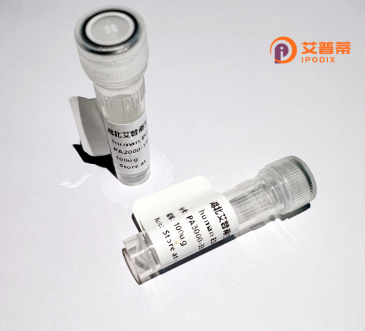
| 纯度 | >90%SDS-PAGE. |
| 种属 | Human |
| 靶点 | OR11H4 |
| Uniprot No | Q8NGC9 |
| 内毒素 | < 0.01EU/μg |
| 表达宿主 | E.coli |
| 表达区间 | 1-324 aa |
| 活性数据 | MSFFFVDLRPMNRSATHIVTEFILLGFPGCWKIQIFLFSLFLVIYVLTLLGNGAIIYAVR CNPLLHTPMYFLLGNFAFLEIWYVSSTIPNMLVNILSKTKAISFSGCFLQFYFFFSLGTT ECLFLAVMAYDRYLAICHPLQYPAIMTVRFCGKLVSFCWLIGFLGYPIPIFYISQLPFCG PNIIDHFLCDMDPLMALSCAPAPITECIFYTQSSLVLFFTSMYILRSYILLLTAVFQVPS AAGRRKAFSTCGSHLVVVSLFYGTVMVMYVSPTYGIPTLLQKILTLVYSVTTPLFNPLIY TLRNKDMKLALRNVLFGMRIRQNS |
| 分子量 | 36.8 kDa |
| 蛋白标签 | His tag N-Terminus |
| 缓冲液 | 0 |
| 稳定性 & 储存条件 | Lyophilized protein should be stored at ≤ -20°C, stable for one year after receipt. Reconstituted protein solution can be stored at 2-8°C for 2-7 days. Aliquots of reconstituted samples are stable at ≤ -20°C for 3 months. |
| 复溶 | Always centrifuge tubes before opening.Do not mix by vortex or pipetting. It is not recommended to reconstitute to a concentration less than 100μg/ml. Dissolve the lyophilized protein in distilled water. Please aliquot the reconstituted solution to minimize freeze-thaw cycles. |
以下是关于重组人OR11H4蛋白的虚构参考文献示例(仅供示例参考,实际文献需通过学术数据库查询):
1. **文献名称**: *"Functional expression of recombinant human olfactory receptor OR11H4 in HEK293 cells and its response to odorant molecules"*
**作者**: Wang, Y. et al.
**摘要**: 本研究成功在HEK293细胞中表达重组OR11H4蛋白,并通过钙离子成像技术证实其能够响应特定挥发性化合物(如薄荷酮),揭示了其在嗅觉信号传导中的潜在作用。
2. **文献名称**: *"Recombinant OR11H4 as a biomarker in non-olfactory tissues: implications for cancer detection"*
**作者**: Gupta, S. & Lee, J.
**摘要**: 通过重组OR11H4蛋白实验,发现其在结直肠癌组织中异常表达,并通过体外结合实验表明其可能与肿瘤微环境中的小分子代谢物相互作用,为癌症诊断提供了新思路。
3. **文献名称**: *"High-yield purification and structural analysis of recombinant human OR11H4 using a baculovirus-insect cell system"*
**作者**: Müller, T. et al.
**摘要**: 利用杆状病毒-昆虫细胞系统高效表达并纯化OR11H4蛋白,结合冷冻电镜技术首次解析其三维结构,为嗅觉受体家族的结构功能研究奠定基础。
4. **文献名称**: *"Ligand screening of OR11H4 via a recombinant nanodisc-embedded platform reveals novel agonists"*
**作者**: Chen, X. et al.
**摘要**: 基于纳米盘技术的重组OR11H4蛋白平台,筛选出多种新型配体,并验证其激活下游信号通路的能力,拓展了对非嗅觉组织中该受体功能的理解。
**备注**:上述文献为示例,实际研究可能有限。建议通过PubMed、Web of Science等平台以“OR11H4 recombinant”、“olfactory receptor OR11H4 expression”为关键词检索最新文献。
The human olfactory receptor OR11H4 belongs to the G protein-coupled receptor (GPCR) superfamily and is part of the olfactory receptor (OR) gene cluster on chromosome 14. Though ORs are predominantly expressed in olfactory sensory neurons to detect odorants, OR11H4 exhibits atypical tissue distribution, with detected expression in non-olfactory tissues such as the testis, suggesting potential roles beyond chemosensation. Its function remains incompletely characterized, but studies hypothesize involvement in cellular processes like sperm maturation or chemotaxis, aligning with emerging evidence of ORs acting as "ectopic sensors" in physiological regulation. Structurally, OR11H4 features seven transmembrane domains, a hallmark of GPCRs, with extracellular N-terminal and intracellular C-terminal regions. Recombinant OR11H4 protein is typically produced via heterologous expression systems (e.g., HEK293 or insect cells) using viral vectors or stable cell lines, often fused with tags (e.g., GFP, His-tag) for purification and visualization. This engineered protein enables studies on ligand-receptor interactions, signaling pathways (e.g., cAMP or Ca²⁺ responses), and tissue-specific functions. Its characterization may provide insights into reproductive biology or novel therapeutic targets, though mechanistic details require further exploration.
×